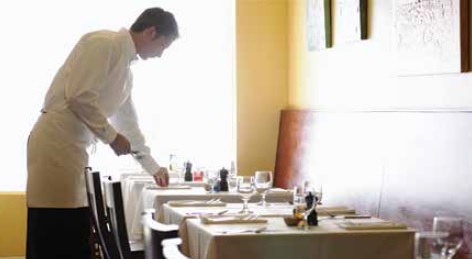St. Genevieve, Chef Steven Brown’s latest establishment, is already attracting the fine dining neighborhood crowd looking for someone setting a high bar. It is a true French bistro of the ilk you would see on the West Bank in Paris or even in Lyon. It’s perfect for the Lynnhurst neighborhood of south Minneapolis, which has well-educated, sophisticated residents and demographics skewed toward the mid-to late-30s to middle- 60s. Brown’s first restaurant, Tilia, is an American classic in the Linden Hills area.
We have not had a true French bistro in Minneapolis before. Which begs the question: Can a true French bistro make it here? Or, are Minnesotans more interested in the French food exemplified by popular, but less authentic, restaurants like Salut?
To hopefully answer those questions, let’s look at the various aspects of St. Genevieve, and at some of the clever ways the bistro will make money.
Revenue
Brown designed an additional meal part, from 2 to 5 p.m., which serves lighter fare, such as tartines (open-faced sandwiches) and Apres Midi (small plates)—all perfect for a “champagne afternoon.” In talking with Brown, he said “Why not? Let’s have as many meal parts as we can.”
Bistro, yes, but St. Genevieve is also a good wine bar, featuring French wines and a large selection of beers. The wine has two pours: small and normal, which they call half and full, but I think the full size is a little short.
Both wines and beers are priced so guests can easily taste a variety. A diner can stop in (like we did one afternoon) for a glass of wine and some great pommes frites and feel like they’ve had a special occasion. This is a great revenue source.
Their pricing is competitive to the other neighborhood chef-driven concepts we’ve reviewed in the past. On the food side, there are three distinct parts to the menu: starters, tartines and entrées, plus desserts and sides. Appetizers run from $9 to a high of $16 for the foie gras.
The opened-faced sandwiches have quite a bit of protein, including one with snails and another with lamb. They range from $12 to $16. Entrées, such as lamb, duck and trout, are in the mid- $20 range.
One constraint on revenue is St. Genevieve does not take reservations. It may create demand now, but once the honeymoon period is over and guests have tasted most dishes, they will probably order two starters and an entrée or two starters and a sandwich. At that point, I believe the check average will come down some. I’m guesstimating it’s around $50 a person now.
The key to revenue is going to be encouraging that second or third glass of wine. Since this is mostly a wine-bar-type venue, more wine by the glass will be sold than bottles. The bartenders’ exacting pours is crucial.
Rating: 3 stars out of 4 stars, particularly since there are three different profit centers.
Ambiance and Capital Investment
The investment was around $500,000, according to Brown. Funding came from an SBA loan, Brown’s own money and some outside investors who like the restaurant space. Brown’s notoriety most likely did not require a deep bench of investors to draw from.
The half-million looks to be well spent—it looks like a French bistro. The bar back, with its regal backstop and distressed mirror, is the center and centerpiece of the restaurant. The flowered wallpaper in the hallway to the restrooms is striking and adds a pop of color. Moving the kitchen from upstairs to downstairs had to have some significant cost. My only concern is that on my visits there, it was almost too loud for conversation. With 12-foot ceilings, and pretty much all hard surfaces, it will be costly to bring the noise level down.
Rating: 3 out of 4 stars
Labor
The servers and hosts are warm and welcoming. The only thing I object to is their policy of not seating a party until all the guests are there. For this type of restaurant it’s not necessary, particularly since people start ordering drinks as soon as they sit down. Once when my son was running late, I had to plead with the host to seat me. They finally consented. And, yes, I ordered a glass of wine right away.
Young, strong servers are needed to go up and down the steps to get the food from the kitchen. If the ordering system goes down, someone will have to run up and down stairs to convey the orders to the kitchen. Bartenders get a break, even though most people sitting at the bar are eating a full dinner there.
It appears to me that there are 15 kitchen workers, for a total of 37 staff. Brown said he is trying to contain the labor costs to 30 percent, but I estimate it is probably 35 to 36 percent. In general, it will be a challenge to figure out the labor model because of the logistics in the restaurant.
Rating: 2 out of 4 stars, but I am sure Brown will fix this.
Food and Food Costs
The pricing is market for food. The types of dishes and overall food costs are around 30 percent. Only a couple of entrées have high protein costs. Otherwise, there’s a lot of bread, sandwiches and other French-style fillers. They should be able to contain their food and beverage costs, and they’ve done a great job making money on the wine.
Rating: 4 out of 4 stars for food costs and profitability.
Overall
I estimate St. Genevieve is a $2 million-plus restaurant, given the table turns I’ve witnessed. Brown thinks they may do $3 million in the first year (the honeymoon period) and then settle down to the $2 million-plus range. (If they do 2.5 table turns per day for 320 days it would generate $3 million.)
Having a real French bistro in an upscale neighborhood is a gift to the entire city. St. Genevieve is not something we thought we would get, but as a cosmopolitan restaurant town, something we deserve.
Rating: 3 out of 4 stars.
From the April 2016 issue of FOODSERVICE NEWS
Author
-

Co-founder and chairman of Monroe Moxness Berg PA, Dennis is a pioneer in corporate financing with a broad network of finance contacts and clients. He assists businesses, from emerging companies to multi-national firms, by providing creative ideas, identifying unique financing sources, and developing the financial tools necessary for their growth and development.
